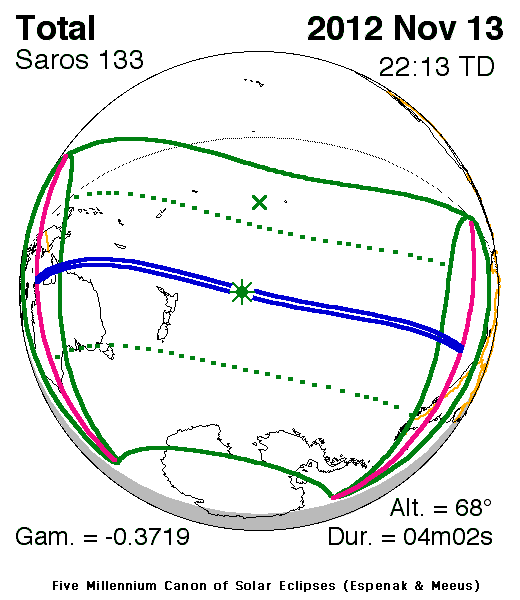
The first solar eclipse of 2012 occurs at the Moon's descending node in central Taurus. An annular eclipse will be visible from a 240 to 300 kilometre-wide track that traverses eastern Asia, the northern Pacific Ocean and the western United States. A partial eclipse is seen within the much broader path of the Moon's penumbral shadow, that includes much of Asia, the Pacific and the western 2/3 of North America
Partial phases of the eclipse are visible primarily from the USA, Canada, the Pacific and East Asia

The first lunar eclipse of 2012 occurs at the Moon's ascending node in southern Ophiuchus about 6° northeast of Antares (mv = +1.07). It is best seen from locations in and near the Pacific Ocean.Most of the Americas will experience moonset before the eclipse ends while eastern Asia will miss the beginning of the eclipse because it occurs before moonrise. The Moon's contact times with Earth's shadows are listed below.
Penumbral Eclipse Begins: 08:48:09 UTPartial Eclipse Begins: 09:59:53 UT
Greatest Eclipse: 11:03:13 UT
Partial Eclipse Ends: 12:06:30 UT
Penumbral Eclipse Ends: 13:18:17 UT
Penumbral Eclipse Begins: 12:14:58 UT
Greatest Eclipse: 14:33:00 UT
Penumbral Eclipse Ends: 16:51:02 UT
At the instant of greatest eclipse the umbral eclipse magnitude will reach 0.3705. At that time the Moon will be at the zenith for observers in the South Pacific. In spite of the fact that just a third of the Moon enters the umbral shadow (the Moon's southern limb dips 12.3 arc-minutes into the umbra), the partial phase still lasts over 2 hours.

The second solar eclipse of 2012 occurs at the Moon's ascending node in central Libra. The path of the Moon's umbral shadow crosses the South Pacific Ocean where it makes no landfall except for northern Australia. The Moon's penumbral shadow produces a partial eclipse visible from a much larger region covering the South Pacific (including Australia and New Zealand), southern South America, and part of Antarctica.

The last lunar eclipse of 2012 is a deep penumbral eclipse with a magnitude of 0.9155. It should be easily visible to the naked eye as a dusky shading in the northern half of the Moon. The times of the major phases are listed below.
Note that the beginning and end of a penumbral eclipse are not visible to the eye. In fact, no shading can be detected until about 2/3 of the Moon's disk is immersed in the penumbra. This would put the period of eclipse visibility from approximately 14:00 to 15:00 UT. Keep in mind that this is only an estimate. Atmospheric conditions and the observer's visual acuity are important factors to consider. An interesting exercise is to note when penumbral shading is first and last seen.
NASA Eclipse Website : http://eclipse.gsfc.nasa.gov/eclipse.html
No comments:
Post a Comment